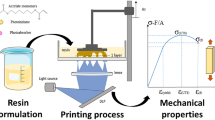Abstract
This study aimed to investigate the strain history of a 3D-printed shape-memory polymer (SMP) and elastomer bilayer specimen under thermal tensile load. First, printing conditions for producing single-layer and bilayer specimens using a fused deposition modeling 3D printer were determined. Tensile tests under thermal effects were then conducted on both specimens. A 1 kg weight was used as a constant tensile load, and temperature cycles ranging from 25 to 65 °C were implemented to determine the thermal effects. The strain history was measured using a strain gauge attached to the specimen during the tests. An initial bending deformation caused by the shrinkage of the elastomer layer was observed in the bilayer specimen immediately after printing. This initial bending was then removed from the bilayer specimen via uniform heating. Strain relaxation was observed in the strain history of the single-layer SMP specimen. Mismatch strain between the two layers of the bilayer specimens was also confirmed from the thermal tensile test results. Analyses and discussions on the strain history data are provided in this paper. In general, this study determined the empirical deformation characteristics of a 3D-printed SMP–elastomer bilayer structure under combined thermal and tensile loading conditions. The results can be used to comprehend the deformation of bilayer SMP–elastomer structures and will be useful for designing a bilayer structure made of 3D-printed SMP material.








Similar content being viewed by others
References
Leng J, Lan X, Liu Y, Du S (2011) Shape-memory polymers and their composites: stimulus methods and applications. Prog Mater Sci 56(7):1077–1135. https://doi.org/10.1016/j.pmatsci.2011.03.001
Liang C, Rogers CA, Malafeew E (1997) Investigation of shape memory polymers and their hybrid composites. J Intell Mater Syst Struct 8(4):380–386. https://doi.org/10.1177/1045389X9700800411
Zare M, Prabhakaran MP, Parvin N, Ramakrishna S (2019) Thermally-induced two-way shape memory polymers: mechanisms, structures, and applications. Chem Eng J 374:706–720. https://doi.org/10.1016/j.cej.2019.05.167
Liu Y, Lv H, Lan X, Leng J, Du S (2009) Review of electro-active shape-memory polymer composite. Compos Sci Technol 69(13):2064–2068. https://doi.org/10.1016/j.compscitech.2008.08.016
Lendlein A, Jiang H, Jünger O, Langer R (2005) Light-induced shape-memory polymers. Nature 434(7035):879–882. https://doi.org/10.1038/nature03496
Du H, Zhang J (2010) Solvent induced shape recovery of shape memory polymer based on chemically cross-linked poly (vinyl alcohol). Soft Matter 6(14):3370–3376. https://doi.org/10.1039/B922220K
Tobushi H, Hayashi S, Kojima S (1992) Mechanical properties of shape memory polymer of polyurethane series: basic characteristics of stress-strain-temperature relationship. JSME 35(3):296–302. https://doi.org/10.1299/jsmea1988.35.3_296
Sokolowski W, Metcalfe A, Hayashi S, Raymond J (2007) Medical applications of shape memory polymers. Biomed Mater 2(1):S23. https://doi.org/10.1088/1748-6041/2/1/S04
Liu Y, Du H, Liu L, Leng J (2014) Shape memory polymers and their composites in aerospace applications: a review. Smart Mater Struct 23(2):023001. https://doi.org/10.1088/0964-1726/23/2/023001
Zhao W, Liu L, Zhang F, Leng J, Liu Y (2019) Shape memory polymers and their composites in biomedical applications. Mater Sci Eng 97:864–883. https://doi.org/10.1016/j.msec.2018.12.054
Metcalfe A, Desfaits AC, Salazkin I, Sokolowski WM, Raymond J (2003) Cold hibernated elastic memory foams for endovascular interventions. Biomaterials 24(3):491–497. https://doi.org/10.1016/S0142-9612(02)00362-9
Lan X, Liu Y, Lv H, Wang X, Leng J, Du S (2009) Fiber reinforced shape-memory polymer composite and its application in a deployable hinge. Smart Mater Struct 18(2):024002. https://doi.org/10.1088/0964-1726/18/2/024002
Hull CW (1990) US Patent No. 4,929,402. Washington DC, US. Patent and Trademark Office
Ngo TD, Kashani A, Imbalzano G, Nguyen KT, Hui D (2018) Additive manufacturing (3D printing): a review of materials, methods, applications and challenges. Compos B Eng 143:172–196. https://doi.org/10.1016/j.compositesb.2018.02.012
Chua CK, Leong KF, Lim CS (2010) Rapid prototyping: principles and applications (with companion CD-ROM). World scientific publishing company
Dudek PFDM (2013) FDM 3D printing technology in manufacturing composite elements. Arch Metall Mater 58(4):1415–1418. https://doi.org/10.2478/amm-2013-0186
Guo H, Lv R, Bai S (2019) Recent advances on 3D printing graphene-based composites. Nano Mater Sci 1(2):101–115. https://doi.org/10.1016/j.nanoms.2019.03.003
Gouzman I, Atar N, Grossman E, Verker R, Bolker A, Pokrass M, Seifarth C (2019) 3D printing of bismaleimides: from new ink formulation to printed thermosetting polymer objects. Adv Mater Technol 4(10):1900368. https://doi.org/10.1002/admt.201900368
Lee JY, An J, Chua CK (2017) Fundamentals and applications of 3D printing for novel materials. Appl Mater Today 7:120–133. https://doi.org/10.1016/j.apmt.2017.02.004
Yang Y, Chen Y, Wei Y, Li Y (2016) 3D printing of shape memory polymer for functional part fabrication. Int J Adv Manuf Technol 84(9–12):2079–2095. https://doi.org/10.1007/s00170-015-7843-2
Zarek M, Layani M, Cooperstein I, Sachyani E, Cohn D, Magdassi S (2016) 3D printing of shape memory polymers for flexible electronic devices. Adv Mater 28(22):4449–4454. https://doi.org/10.1002/adma.201503132
Ge Q, Dunn CK, Qi HJ, Dunn ML (2014) Active origami by 4D printing. Smart Mater Struct 23(9):094007. https://doi.org/10.1088/0964-1726/23/9/094007
Mao Y, Ding Z, Yuan C, Ai S, Isakov M, Wu J, Qi HJ (2016) 3D printed reversible shape changing components with stimuli responsive materials. Sci Rep 6(1):1–13. https://doi.org/10.1038/srep24761
Torrado AR, Roberson DA (2016) Failure analysis and anisotropy evaluation of 3D-printed tensile test specimens of different geometries and print raster patterns. J Fail Anal Prev 16(1):154–164. https://doi.org/10.1007/s11668-016-0067-4
Torrado AR, Shemelya CM, English JD, Lin Y, Wicker RB, Roberson DA (2015) Characterizing the effect of additives to ABS on the mechanical property anisotropy of specimens fabricated by material extrusion 3D printing. Addit Manuf 6:16–29. https://doi.org/10.1016/j.addma.2015.02.001
Acknowledgements
The authors would like to thank Prof. Kikuo Kishimoto for helpful suggestions and Mrs. Masayo Ishikawa for technical assistance. This work was supported by JSPS KAKENHI Grant Number JP19K04087.
Author information
Authors and Affiliations
Corresponding author
Ethics declarations
Conflict of interest
The authors declare that there is no conflict of interest.
Additional information
Publisher's Note
Springer Nature remains neutral with regard to jurisdictional claims in published maps and institutional affiliations.
Rights and permissions
About this article
Cite this article
Su, Z., Inaba, K. & Triawan, F. Strain history of 3D printed bilayer structure with flexible elastomer and shape memory polymer filaments during thermal tensile test. Prog Addit Manuf 6, 643–652 (2021). https://doi.org/10.1007/s40964-021-00185-3
Received:
Accepted:
Published:
Issue Date:
DOI: https://doi.org/10.1007/s40964-021-00185-3




